Click on images to enlarge
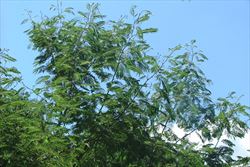
habit (Photo: Sheldon Navie)

habit in fruit (Photo: Sheldon Navie)
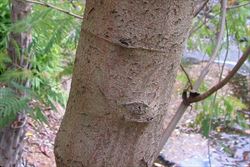
bark on trunk of mature tree (Photo: Sheldon Navie)

younger stem, with fine ridges or striations, and leaf stalks with swollen bases (Photo: Sheldon Navie)
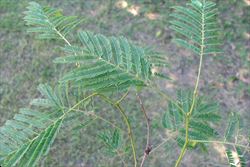
the twice-compound leaves (Photo: Sheldon Navie)

close-up of leaf with numerous tiny, elongated, leaflets (Photo: Sheldon Navie)
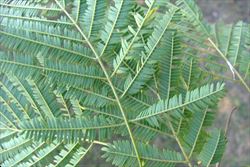
underside of leaf showing fine hairs on the leaf stalk and leaf branchlets (Photo: Sheldon Navie)

flowers in loose globular clusters (Photo: Sheldon Navie)
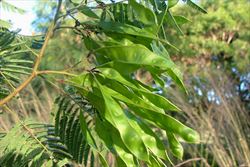
immature fruit (Photo: Sheldon Navie)
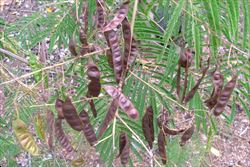
mature fruit (Photo: Sheldon Navie)
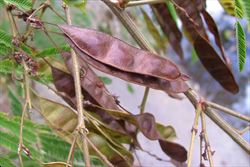
close-up of mature fruit (Photo: Sheldon Navie)
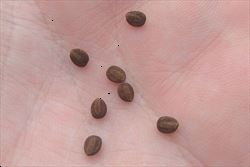
close-up of seeds (Photo: Sheldon Navie)
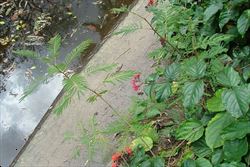
young plants (Photo: Sheldon Navie)
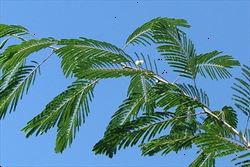
twice-compound leaves with about 11-17 pairs of branchlets (Photo: Sheldon Navie)

flowers in loose globular clusters in the upper leaf forks (Photo: Sheldon Navie)
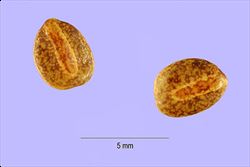
close-up of seeds (Photo: Tracey Slotta at USDA PLANTS Database)
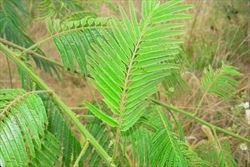
fern acaia (Acaciella filicoides) has leaves with more than 17 pairs of branchlets (Photo: Chris Gardiner)
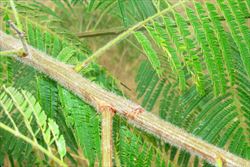
the very hairy stems and leaf stalks of fern acacia, Acaciella filicoides (Photo: Chris Gardiner)
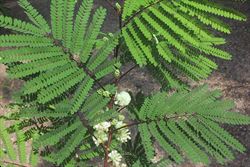
redwood (Acaciella glauca), with reddish-coloured younger stems and broader, rounded, leaflets (Photo: Chris Gardiner)
Scientific Name
Acaciella angustissima (Mill.) Brit. & Rose
Synonyms
Acaciella angustissima (Mill.) Brit. & Rose var. angustissima Acacia boliviana Rusby
Family
Fabaceae: sub-family Mimosoideae (New South Wales)Leguminosae (South Australia)Mimosaceae (Queensland, the ACT, Victoria, Tasmania, Western Australia and the Northern Territory)
Common Names
Bolivian wattle
Origin
Native to South America (i.e. Bolivia, Peru and Argentina).
Cultivation
This species has been cultivated in a few locations as part of fodder tree trials (e.g. Millaroo Research Station, Walkamin Research Station and on a grazing property in Central Queensland). These trials demonstrated that it had moderate palatability to grazing cattle, however research was not continued due to its perceived risk as a potential weed. It is generally not grown as an ornamental species, but at least one specimen has been reported from a botanic garden.
Naturalised Distribution
Bolivian wattle (Acaciella angustissima) was introduced into Queensland as part of research to find new fodder shrubs for cattle. It has so far only become sparingly naturalised along a short section of Witton Creek in Indooroopilly in suburban Brisbane.
Habitat
The only naturalised population was found growing along a waterway in south-eastern Queensland. However, this species is thought to be suited to coastal habitats in the tropical and sub-tropical regions of Australia.
Habit
A large shrub or small tree growing up to 4 m or more in height.
Distinguishing Features
- a large shrub or small tree with twice-compound leaves.
- its young branches are often finely hairy and have numerous small narrow ridges running lengthwise.
- its leaf-stalks are hairy and do not bear any raised structures.
- its whitish flowers are borne in small globular clusters and are arranged into larger compound clusters in the leaf forks.
- its elongated and very flattened pods (40-85 mm long) are often twisted and come to an abruptly pointed tip.
Stems and Leaves
The stems of this species do not bear any thorns and are often somewhat bent or winding in nature (i.e. flexuous). Older stems are covered in a relatively smooth, or slightly rough, brown or brownish-grey coloured bark. Younger branches are almost round in cross-section with numerous small narrow ridges running lengthwise (i.e. they are striated). They are either hairless or have a covering of tiny coarse stiff hairs (i.e. hirsute).
The leaves (10-25 cm long) are twice-compound (i.e. bipinnate) and alternately arranged along the stems. Each leaf is borne on a stalk (i.e. petiole) 20-45 mm long and has 9-25 pairs of branchlets (i.e. pinnae). Where the leaf stalk (i.e. petiole) joins to the stem there is a short thickened structure (i.e. a pulvinus) and the leaf stalks and leaf branchlets have a covering of soft hairs (i.e. they are villous). Each of the leaf branchlets (i.e. pinnae) bears numerous (mostly 30-60) pairs of tiny leaflets (i.e. pinnules). These leaflets (3-4 mm long and 0.5-1 mm wide) are hairless except for a line of tiny hairs (i.e. cilia) along their margins. They are elongated in shape (i.e. almost linear), with paler undersides and slightly pointed tips (i.e. acute apices).
Flowers and Fruit
The cream or whitish-coloured flowers are fluffy in appearance due to the presence of numerous stamens. They are arranged into small rounded or slightly elongated (i.e. sub-globose) clusters (6-10 mm across), each containing several to numerous (9-18) flowers. Each individual flower in this cluster has five relatively inconspicuous petals (about 2.5 mm long) and sepals (about 1 mm long) and is borne on a very short stalk (i.e. pedicel). The flower clusters are borne on relatively long stalks (i.e. peduncles) that emanate from the forks of the leaves (i.e. they are axillary), or are occasionally borne in branched clusters at the tips of the branches (i.e. in irregular terminal panicles). Flowering is known to occur during summer and early autumn (i.e. from January to March) in southern Queensland.
The fruit is an elongated and flattened pod (40-85 mm long and 8-14 mm wide) with an abruptly pointed tip (2-7 mm long). These pods are not constricted between the seeds and are either straight or somewhat twisted in nature. They are pale green and glossy in appearance when young and generally turn reddish-brown or dark brown as they mature. Fruit are known to be present during autumn and winter (i.e. from May to August) in southern Queensland. The seeds are almost rounded in shape, but somewhat flattened (about 4 mm long and 3.5 mm wide), and usually have a mottled appearance (i.e. pale green and brown in colour).
Reproduction and Dispersal
Bolivian wattle (Acaciella angustissima) produces numerous hard seeds, that are probably long-lived like those of other wattles. These seeds may be dispersed by animals that consume them (e.g. cattle or birds) or by water movement.
Environmental Impact
Bolivian wattle (Acaciella angustissima) is not yet causing any significant environmental damage in Australia, but it is thought to have the potential to cause significant harm if it is allowed to become widely naturalised. Even prior to when it become naturalised it was considered to be a potential environmental weed and was listed as a candidate species for preventative control in Queensland. This led to the cessation of all fodder trials involving this species.
Subsequent reports of its naturalisation confirmed these predictions and, due mainly to its potential invasiveness, it was recently included in the list of the 200 most significant invasive naturalised plants of south-eastern Queensland.
Legislation
This species is declared under legislation in the following states and territories:
- Queensland: Class 1 - introduction into the state is prohibited, and landowners must
take reasonable steps to keep land free of this species (throughout the entire
state). It is also illegal to sell a declared plant or its seed in this state.
- Western Australia: P1 - trade, sale or movement into the state prevented, and P2 - to be eradicated where found (throughout the entire state). Note: all non-indigenous species of Acacia are declared in this state, except mimosa bush (Vachellia farnesiana, syn. Acacia farnesiana).
Management
Similar Species
Bolivian wattle (Acaciella angustissima) is very similar to several other Acaciella species that are naturalised or have been cultivated in trial sites in Queensland (i.e. Acaciella filicoides, Acaciella texensis and Acaciella glauca). These plants can be distinguished by the following differences:
- Bolivian wattle (Acaciella angustissima) has finely hairy are almost hairless younger branches and leaf stalks, and its leaves usually have 11-17 pairs of branchlets. Its small leaflets (2.4-3.2 mm long and about 0.5 mm wide) are elongated in shape and have pointed tips.
- fern acacia (Acaciella filicoides) has densely hairy younger branches and leaf stalks, and its leaves usually have 18-32 pairs of branchlets. Its small leaflets (2.4-3.2 mm long and about 0.5 mm wide) are elongated in shape and have pointed tips.
- prairie wattle (Acaciella texensis) has hairless or almost hairless younger branches and leaf stalks, and its leaves usually have 3-6 pairs of branchlets. Its small leaflets (2.4-3.2 mm long and about 0.5 mm wide) are elongated in shape and have pointed tips.
- redwood (Acaciella glauca) has mostly hairless younger branches and leaf stalks that are often reddish in colour, and its leaves have only 2-8 pairs of branchlets. It relatively large leaflets (3.5-9 mm long and about 1.8-6 mm wide) are oval in shape and usually have rounded tips.
Bolivian wattle (Acaciella angustissima) is also similar to several native wattles with white flowers and twice-compound (i.e. bipinnate) leaves, but can generally be distinguished from the native wattles (e.g. Acacia irrorata) by the fact that it does not have any small raised structures (i.e. glands) on its leaf stalks.
For a more in-depth key to all of the wattles (Acacia spp.) present in Australia, see the Wattle: Acacias of Australia CD-ROM or Flora of Australia, Volumes 11A and 11B.

